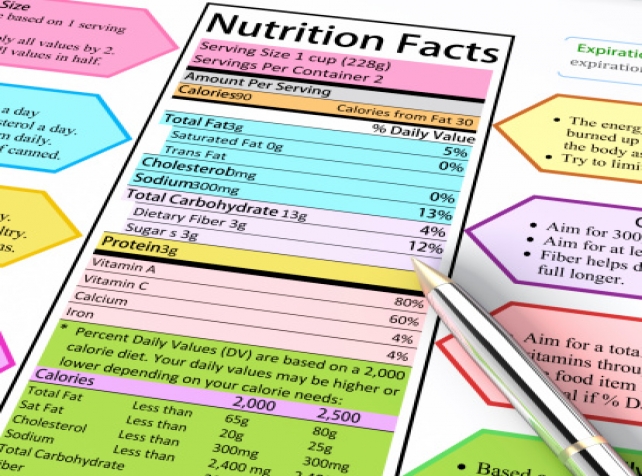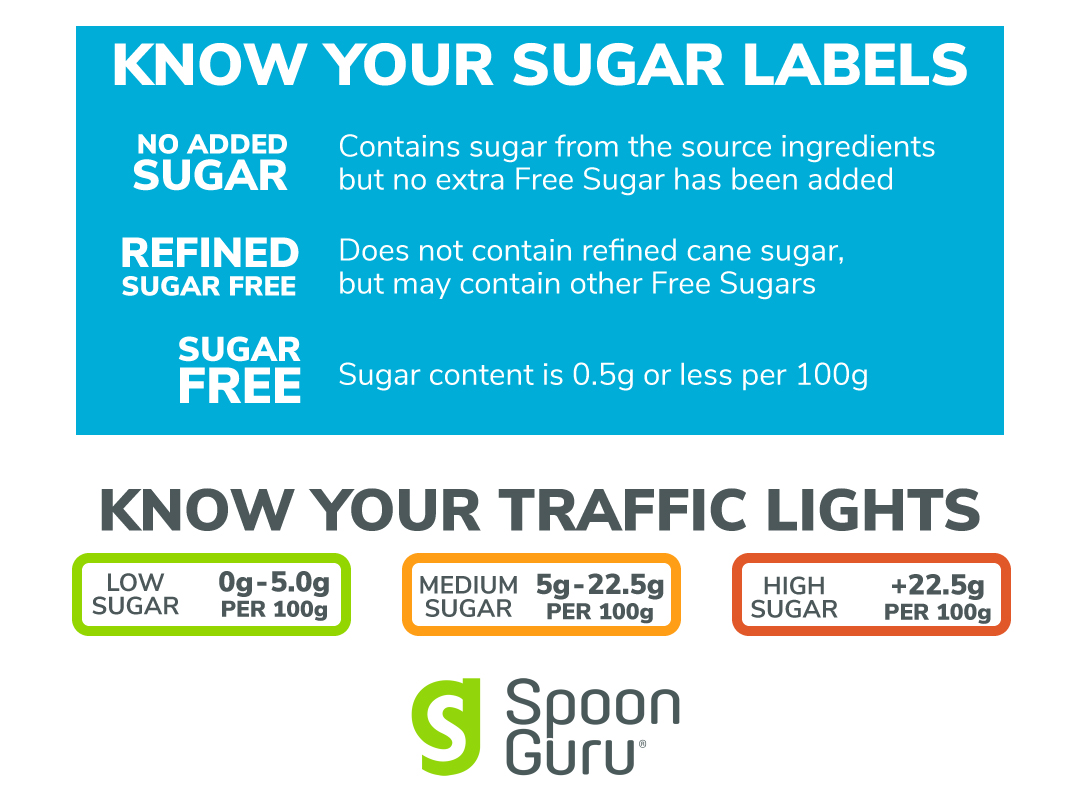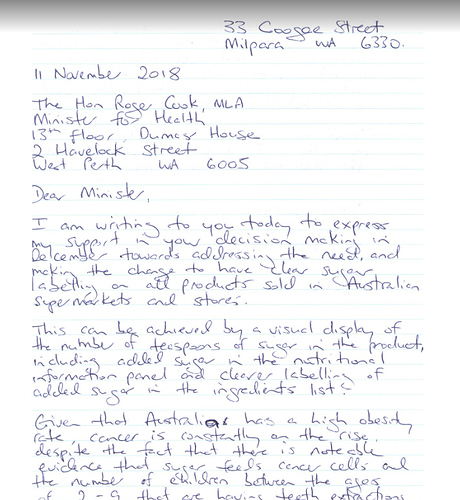45 how to read labels for sugar
Sugars on food labels - Sugar Nutrition Resource Centre Polys or sugar alcohols are naturally found in some fruits and used commercially in products such as chewing gum. Packaged foods in Australian and New Zealand must provide nutrition information on the labels, including ingredients, nutrition information panels and content claims. Food Standards Australia New Zealand (FSANZ) are the regulatory ... Understanding sugar content on food labels - Diabetes Care Community Reading the ingredient lists and nutrition facts tables on packaged foods is a helpful way for you to check what kind, and how much, sugar a product has. Finding sugar content in the ingredients list The ingredients are listed in order of weight, beginning with the ingredient that weighs the most and ending with the ingredient that weighs the ...
How to Read Food Labels Without Being Tricked - Healthline This label usually means that the fat has been reduced at the cost of adding more sugar. Be very careful and read the ingredients list. Low-carb. Recently, low-carb diets have been linked to...

How to read labels for sugar
Food labels - NHS Colour-coded nutritional information tells you at a glance if the food has high, medium or low amounts of fat, saturated fat, sugars and salt: red means high amber means medium green means low In short, the more green on the label, the healthier the choice. How to Understand and Use the Nutrition Facts Label | FDA It's important to realize that all the nutrient amounts shown on the label, including the number of calories, refer to the size of the serving. Pay attention to the serving size, especially how ... How to Read Nutrition Labels When You Have Diabetes - WebMD Getting Past the Guilt of Type 2. See how one patient learned to manage her weight and diet.
How to read labels for sugar. Food Labels | CDC If you eat the whole thing, you are eating 8 times the amount of calories, carbs, fat, etc., shown on the label. Total Carbohydrate shows you types of carbs in the food, including sugar and fiber. Choose foods with more fiber, vitamins, and minerals. Choose foods with lower calories, saturated fat, sodium, and added sugars. How to Read Labels for Added Sugar | Naturally Savvy Here are all the many types of sugar and their various names to hunt out in an ingredient list: Anhydrous dextrose Barley malt Beet sugar Brown sugar Cane juice crystals Cane sugar Caramel Corn sweetener Corn syrup Corn syrup solids Confectioner's sugar Carob syrup Castor sugar Date sugar Demerara sugar Dextran Dextrose Diastatic malt Diatase How to read labels for added sugar - That Sugar Movement Look past the clever marketing and fancy health claims on the packaging and learn how to read labels and identify added sugars. Here is our three-step guide on how! One: Look for foods under 5g total sugar/100g In Australia, the Nutrition Information Panel (NIP) on the back of food and drink packaging lists total sugars content. Counting Sugar Alcohols :: Diabetes Education Online When counting carbohydrates for products made with sugar alcohols, subtract half of the grams of sugar alcohol listed on the food label from the total grams of carbohydrate. Remember that because sugar alcohols are harder for your body to digest, eating too many sugar alcohols may cause digestive complaints like gas, cramping and diarrhea.
Sneaky Sugars: How to read food labels - Natvia Sugar can be labelled as many different names, but no matter what you call it, it's still the same stuff! Here's some of the most common (but be warned, there are more than 50 ways of labelling sugar !) Agave nectar/syrup Brown rice syrup/rice syrup/rice malt Corn sweetener High Fructose Corn Syrup/ Corn Syrup Crystalline fructose Ethyl maltol Learning To Read Labels :: Diabetes Education Online The grams of sugar listed include both natural sugars, from fruit or milk, and added sugars. On a nutrition food label, the total carbohydrate includes the sugar. Some Nutrition Facts labels may also list sugar alcohols under total carbohydrate. Sugar alcohols may be found in products that are labeled "sugar-free" or "no sugar added." Understanding food labels - Action on Sugar Step 1 - Calculate amount of sugars per gram by dividing the amount of sugars per 100g OR 100ml by 100. Step 2 - Check the weight of a recommended portion as stated on the pack. Step 3 - Work out the amount of there is per portion by multiplying the figures from step 1 and 2. Are You Confused? How to Read Sugar Labels - Thin Strong Healthy You need to know. Start dividing those grams of sugar by 4 to give you the teaspoons in a serving. Then look at the serving to see what a realistic amount would be for an actually serving. Learn to read sugar labels. They think you don't know what they're doing. Now you do. Take back your health, and don't let big food win!
How to Spot Hidden Sugar on Food Labels! - Dr. Michelle Pfeffer Start by looking at the carbohydrate count on the nutrition label. Under carbohydrates you will see a total carbohydrate measurement and then a breakdown to sugars and fiber. If the sugar number is most of the carbohydrate number then there is more than a lot of sugar in that food item. Now, look at the ingredient list. Reading Food Labels | ADA - American Diabetes Association Put food labels to work. The Nutrition Facts labels on foods are really the key to making the best choices. We'll cover the basics so that these labels make shopping easier for you. You've heard it all. From carb-free to low-carb, to whole and empty carbs, it's hard to know what it all means. Blood sugar highs and lows aren't always ... How to Read Nutrition Labels for Sugar - hekagoodfoods Where to Find the Nutrition Label Why Added Sugar is on the New Nutrition Labels What to Look for in the Ingredients List Top Three Ingredients Sugar Listed Under Multiple Names More Fiber, Less Sugar Where to Find the Nutrition Label You'll usually find the nutrition facts label on the side or back panel of a packaged food. How To Read Food and Beverage Labels | National Institute on Aging Be on the lookout for terms that indicate added sugar, such as brown sugar, corn sweetener, corn syrup, dextrose, fructose, and high-fructose corn syrup. Artificial sweeteners such as sucralose, saccharin, aspartame, and acesulfame should also be consumed in moderation.
How to Read a Food Label to Make Sure It's Keto in 3 Easy Steps Look for a brand that indicates "No Sugar Added". Read the ingredient list to verify. Pederson's brand with the No Sugar-Whole30 Approved seal is my personal choice. 2. Go to the butcher. You can find him in the grocery store by the meat section or at your local butcher shop. Ask him to cut you strips of pork belly, bacon style.
Sugar Alcohols on Nutrition Labels - ReciPal For Canadian (CFIA) labels, showing sugar alcohol in the nutrition panel is always mandatory when you have any sugar alcohol in your product. The line for it will be included automatically in your ReciPal label when you choose the Canadian format if the sugar alcohol line is more than 0 grams. Toggling sugar alcohols on a nutrition label.
How To Read Sugar Labels (And Cut Back On Your Intake) Whatever the last ingredient is what it's made up of least," McLeod said. Hedge agrees that this is one of the best ways to read the sugar content. "If sugar appears in the first five ingredients, that should send a little warning," Hedge said. 2. Look at the overall sugar content. To help figure out how much sugar is in a product ...
How to Read Carbohydrates on Food Labels - GlycoLeap A simpler way to detect high sugar products is to scan through the ingredients list. Make sure that sugar is not on the first 3 ingredients. The lower it is on the ingredients list, the better. Beware of words like 'concentrate', 'syrup', 'juice', 'crystals', and words ending in -ose, which are probably names of different sugar types.
How To Read Food labels for Sugar | My Sugar Free Kitchen On the label check the sugars in the nutrition panel. 5g/ml or less of sugar per 100g/ml = this would count as low sugar content. It means 5% of the ingredients are sugar Between 5g/ml and 20g/ml of sugar per 100 grams = medium sugar content. With 20ml of sugar per 100 ml, this means the product is 20% sugar…not so good.
5 ways to spot added sugars on food labels - Tryon Medical Partners Raw sugar. 2. Look for the word "includes". Recently, the Food and Drug Administration mandated that manufacturers must list added sugars in grams and as a percentage of the Daily Value. Now food labels have the word "includes" before added sugars to indicate that added sugars are included in the number of grams of total sugars in the ...
How to Read a Label - Natural Sugar versus Added Sugar You can tell them apart by reading the list of INGREDIENTS on the label just under the Nutrition Facts box. Locate the *Ingredients* list on the food label. Trick is to differentiate between ingredients that add sugar (high fructose corn syrup or sucrose) and ingredients that have natural sugar that is inherent in the raw or base food.
Added Sugars on the New Nutrition Facts Label | FDA Labels for foods and beverages with added sugars will list the number of grams and the percent Daily Value (%DV) for added sugars within the Nutrition Facts label. Having the word "includes" before...

Effective Tips For Reducing Sugar In Diet - Diet Remedy For Sugar | Find Home Remedy & Supplements
Reading food labels: Tips if you have diabetes - Mayo Clinic Look for foods with 3 or more grams of fiber. Put sugar-free products in their place Sugar-free doesn't mean carbohydrate-free. Sugar-free foods may play a role in your diabetes diet, but remember that it's equally important to consider carbohydrates as well. A sugar-free label means that one serving has less than 0.5 grams of sugar.
How to Read Nutrition Labels When You Have Diabetes - WebMD Getting Past the Guilt of Type 2. See how one patient learned to manage her weight and diet.
How to Understand and Use the Nutrition Facts Label | FDA It's important to realize that all the nutrient amounts shown on the label, including the number of calories, refer to the size of the serving. Pay attention to the serving size, especially how ...
Food labels - NHS Colour-coded nutritional information tells you at a glance if the food has high, medium or low amounts of fat, saturated fat, sugars and salt: red means high amber means medium green means low In short, the more green on the label, the healthier the choice.










Post a Comment for "45 how to read labels for sugar"